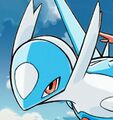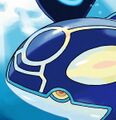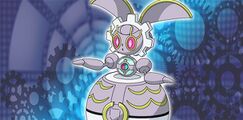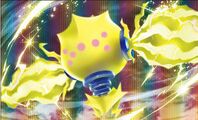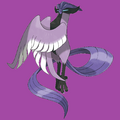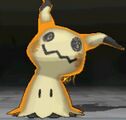Join the Discord →
Learn More →
See Project →
See About page
Pokémon

|
"Under Construction!" |
| This article or section will be subject to revision in the near future. The current statistics or information does not fully reflect our views. |

| “ | Gotta Catch 'em All! | „ |
For detailed information about this series, visit Bulbapedia or the Pokémon Wiki.
Background
Pokémon is a series of video games developed by Game Freak and published by Nintendo and The Pokémon Company under the Pokémon media franchise. Created by Satoshi Tajiri with assistance from Ken Sugimori, the first games, Pocket Monsters Red and Green, released in 1996 in Japan for the Game Boy, later released outside of Japan as Pokémon Red and Blue and the main series of role-playing video games, referred as the "core series" by their developers, have continued on each generation of Nintendo's handhelds.
The core games are released in generations, each with different Pokémon, storylines, and characters. Remakes of the games are usually released around a decade after the original versions for the latest console at the time. While the main series consists of RPGs developed by Game Freak, many spin-off games based on the series have been developed by various companies, encompassing other genres such as action role-playing, puzzle, fighting, and digital pet games.
Pokémon is the world's largest media franchise, with successful anime series, movies, and merchandise, with spin-off game Pokémon Go having crossed 1 billion mobile game downloads worldwide. By November 24, 2017, more than 300 million Pokémon games had been sold worldwide on handheld and home consoles, across 76 titles, including spin-offs. As of March 2021, the series has sold over 380 million units worldwide. This makes Pokémon the fourth best-selling video game franchise, behind Nintendo's own Mario franchise, Tetris and Call of Duty.
Power of the Verse
Pokémon will vary extremely in terms of strength, speed, and abilities. This includes (but is not limited to) Superhuman Physical Characteristics, Non-Standard Interaction, Intangibility, Incorporeality, Water Manipulation, Ice Manipulation, Earth Manipulation, Metal Manipulation, Fire Manipulation, Magma Manipulation, Inorganic Physiology, Self-Sustenance, Water Walking, Flight, Power Modification, Power Nullification, Air Manipulation, Poison Manipulation, BFR, Energy Projection, Light Manipulation, Power Bestowal, Power Mimicry, Regeneration, Status Effect Inducement, Empathic Manipulation, Pain Manipulation, Spike Manipulation, Resurrection, Mind Manipulation, Sound Manipulation, Homing Attack, Corrosion Inducement, Electricity Manipulation, Electromagnetism Manipulation, Gravity Manipulation, Soul Manipulation, Pocket Reality Manipulation, Damage Transferal, Rage Power, Adaptation, Dream Manipulation, Duplication, Afterimage Creation, Forcefield Creation, Invulnerability, Absolute Zero, Absorption, Extrasensory Perception, Resistance Negation, Morality Manipulation, Probability Manipulation, Supernatural Luck, Sheer Will, Fear Manipulation, and many, many more.
Explanations
- This blog goes over why the main characters of the series are given the Pokémon Teams that they are given, since they have a wide variety to choose from.
Terms
- Pokémon: Pokémon (Japanese: ポケットモンスター Pocket Monsters; ポケモン Pokémon for short) are fictional creatures that are central to the Pokémon franchise. There are currently 898 known species that inhabit the Pokémon world; however, it is implied that there are more waiting to be discovered. Inherent to them are several fantastic powers not demonstrated by most real animals, such as the manipulation of elements/aspects of life, such as electricity or fire. Pokémon are shown to exist instead of animals in their world, although animals are also seldom seen in older media. While most Pokémon resemble animals and may behave like them, there are many that do not resemble animals at all, taking on other forms such as plants, inanimate objects, machines, human-like forms, or other more enigmatic and exotic appearances. Pokémon inhabit an extremely diverse range of habitats, ranging from the driest deserts to the lushest jungles, the deepest oceans to the highest mountains and everything else in-between, even outer space and other dimensions. Pokémon take up various ways of living in those places. However, all can be befriended and made into potential allies. Many Pokémon are able to evolve from or into other Pokémon, a process that typically makes them larger and stronger, and more closely resembles growth and development or metamorphosis rather than evolution in the real world. Pokémon typically know several techniques that they can use in battle or elsewhere, either to defend themselves or their Trainer, or to perform a task. In the anime, most Pokémon are known only to say their name. In the games, each Pokémon has a distinct voice associated with each species.
- Legendaries: Legendary Pokémon (Japanese: 伝説のポケモン Legendary Pokémon) are a group of incredibly rare and often very powerful Pokémon, generally featured prominently in the legends and myths of the Pokémon world. Legendary Pokémon are usually encountered as interactable or roaming Pokémon. Starting in Platinum, legendary Pokémon will reappear when the player defeats the Champion if the Pokémon fainted earlier. The Sex of most Legendary Pokémon is unknown (though there are nine notable exceptions: Latios, Latias, Heatran, Cresselia, Tornadus, Thundurus, Landorus, Kubfu, and Urshifu). In the core series games, no Legendary Pokémon can breed or hatch from an Egg. With the exception of Type: Null, Cosmog, and Kubfu, and their respective evolutionary families, Legendary Pokémon cannot evolve, although many are able to change form and are part of a duo or trio. Much like starter Pokémon appear at the beginning of each regional Pokédex and their generation's portion of the National Pokédex, Mythical Pokémon typically appear at the very end, and Legendary Pokémon immediately before them.
- Mythicals: Mythical Pokémon (Japanese: 幻のポケモン Illusory Pokémon) are a group of Pokémon seen so rarely in the Pokémon world that some question their very existence. In Japanese media, Mythical Pokémon and Legendary Pokémon have always been presented as distinct groups. In non-Japanese media prior to Generation V, Mythical Pokémon and Legendary Pokémon were both considered to be Legendary Pokémon (and the term Mythical Pokémon was unused, with some fans calling Mythical Pokémon "Event Legendaries", reflecting how they usually must be obtained at an event, but they are not a subset of them); since Generation V, the two groups are presented as distinct groups in all official media. In Pokémon Ranger: Guardian Signs, Mythical Pokémon are referred to as rare Pokémon. Mythical Pokémon are regarded as among the rarest in Pokémon world mythology. Some are seemingly unknown to most people, while others are thought of as stuff of legends. They typically receive minimal exposure during normal gameplay, usually alluded to in vague hints. They are then revealed to players months or years after the debut of their respective generation. Upon being revealed, they are celebrated across the numerous media, often starring in movies and being featured prominently in merchandise. When they are first revealed, Mythical Pokémon cannot be obtained in the core series games in the course of normal gameplay. They can typically only be obtained by Mystery Gift (either directly, or using an event item). They are distributed to players via Mystery Gift on special occasions such as screenings of Pokémon movies, events in retail stores, online distributions, and the Pokémon 20th Anniversary, or may be received via spin-off games that feature special connectivity. With few exceptions, Mythical Pokémon have never been obtainable in regular gameplay. The Sex of every Mythical Pokémon is unknown. Almost all Mythical Pokémon cannot evolve, with the exception of Meltan, and most cannot breed, although Manaphy and Phione can be bred with Ditto to produce Phione Eggs. Much like starter Pokémon appear at the beginning of each regional Pokédex and their generation's portion of the National Pokédex, Mythical Pokémon typically appear at the very end, and Legendary Pokémon immediately before them. The Mythical Pokémon Victini is the only exception, which appears at the start of the Unova Pokédex as #000, coming before the region's starter Pokémon in the Pokédex. No Mythical Pokémon is required to complete the Pokédex for the Diploma, except in Pokémon Omega Ruby and Alpha Sapphire, which require the player to obtain Deoxys to complete the National Pokédex Diploma due to it being available as part of the Delta Episode.
- Z-Moves: A Z-Move (Japanese: Zワザ Z-Move) is a special type of move exclusive to the Generation VII games Sun, Moon, Ultra Sun, and Ultra Moon, in which a Trainer and their Pokémon's wishes combine to unleash an attack comprising the full power of both. These moves are very powerful, but they can only be used once per battle, unless Z-Rotom Power is used. There are three different kinds of Z-Moves: Z-Moves which can be used by any Pokémon, with one Z-Move for each of the 18 types; status moves that have been turned into Z-Moves by one of the 18 type-specific Z-Crystals; and Z-Moves that can only be used by specific Pokémon. The Z-Move that a Pokémon can perform depends on the Z-Crystal it holds. There are 18 different Z-Crystals that correspond to each of the 18 types, and several others that correspond to specific Pokémon. Z-Moves work by powering up one of the Pokémon's normal moves, so the Pokémon must also know an appropriate move. For the type-related Z-Crystals, the Pokémon must know a move of the same type as the Z-Crystal it is holding. For the Pokémon-specific Z-Crystals, the move required differs for each Pokémon.
- Mega Evolution: Mega Evolution (Japanese: メガシンカ Mega Evolution) is a temporary transformation introduced in Generation VI that affects certain Pokémon. Mega-Evolved Pokémon are identified by having "Mega" in front of their name. In the core series, Mega Evolution requires the player to hold a Key Stone and a Pokémon capable of Mega Evolution holding its compatible Mega Stone (except in Pokémon Let's Go, Pikachu! and Let's Go, Eevee! in which the player simply needs to have the Mega Stone in their bag). While Mega Evolution is also available in the Generation VII games, including in Pokémon Let's Go, Pikachu! and Let's Go, Eevee! (Despite being based in Kanto), it has been removed from Pokémon Sword and Shield, due to the lack of Key Stones and Mega Stones. In order to Mega Evolve, most Pokémon must be holding their appropriate Mega Stone and the Trainer must have a Key Stone. Only Rayquaza does not need a Mega Stone to Mega Evolve; instead, it must know the move Dragon Ascent.
- Types: Types (Japanese: タイプ Type) are properties for Pokémon and their moves. As of Generation VI, there are 18 types, as listed to the right. Most of these were introduced during Generation I, but the Dark and Steel types were introduced in Generation II and the Fairy type was introduced in Generation VI. A unique ??? type also existed from Generations II through IV. During Generation I, types were occasionally referred to as elements. The types are based on the concept of classical elements in popular culture. A Pokémon may have either one or two types: For instance, Charmander is a Fire type, while Bulbasaur is both a Grass type and a Poison type. With the current 18-type system, there are a total of 324 possible ways to assign types to Pokémon, with 171 unique combinations. As of Generation VIII, 154 different type combinations have been used. Similar to Pokémon, Pokéstar Studios opponents also have types. A move has exactly one type. The type of a damaging move typically defines which types of Pokémon it is super effective against, which types of Pokémon it is not very effective against, and which types of Pokémon it is completely ineffective against. (Uniquely, Flying Press is a Fighting-type move but has the type effectiveness of both a Fighting- and Flying-type move.) If the type of a move matches one of the types of the Pokémon using it, it gains a boost in power.
- Dynamax: Dynamax (Japanese: ダイマックス Daimax) is a temporary transformation affecting Pokémon that was introduced in Generation VIII. Trainers who obtain a Dynamax Band are able to Dynamax their Pokémon. According to Professor Magnolia, the Pokémon distorts space to change its size while affecting the world around them. This transformation has another special variant known as Gigantamax. Dynamaxing increases a Pokémon's size drastically, as well as changing the moves of the Pokémon and increasing their HP in battle (except for Shedinja), but can only be used once during a battle, and ends after three turns or if the user is switched out. In addition, it can only be performed in areas known to have Power Spots, such as Galar's Gym Stadiums, Battle Court, and Battle Tower. When Dynamaxed, all of the Pokémon's moves will turn into Max Moves that correspond to those moves' types and categories. Like with Mega Evolution, Dynamax is activated at the start of the turn before all other moves are executed. If a Dynamax Pokémon runs out of PP of one move, it still can be selected but fails; if it is unable to use any moves (e.g., running out of PP), it will use Struggle. In a Max Raid Battle, the wild Pokémon is a Dynamax Pokémon for the entire duration of the battle. Only one of the Trainers' Pokémon can Dynamax during a Max Raid Battle, and only for the standard three turns. The first Trainer with the chance to Dynamax is the host, with the chance passing to the next player who joined until it returns to the first player.
- Gigantamax: Gigantamax (Japanese: キョダイマックス Kyodaimax) is a special kind of Dynamax introduced in Generation VIII. Like other Dynamaxing, Gigantamaxing increases a Pokémon's size drastically and its HP in battle. Only certain species of Pokémon can Gigantamax, and when they do, their appearance changes significantly, unlike regular Dynamaxing. As revealed by Professor Magnolia, the Pokémon distorts space to change its size while affecting the world around them while altering their appearance drastically. In its Gigantamax form, a Pokémon can use a G-Max Move. Each G-Max Move is exclusive to a specific species of Gigantamax Pokémon. All of a Gigantamax Pokémon's moves of a certain type turn into G-Max Moves instead of their corresponding Max Move. Outside of G-Max Moves, Gigantamax is functionally identical to Dynamax; Pokémon's HP increases according to its Dynamax Level, while all other stats and its Ability remain the same.
Verse Scaling
Every main Pokémon will scale to others who can use Earth Power, a move that reaches Multi-City Block level strength, alongside downscaling from moves such as Explosion and Self-Destruct, which also reach this level of strength.
Baby Pokémon scale to the Building level durability of Cleffa, which, to be more specific, was calculated to be this strong, and they are capable of harming Cleffa.
Many Legendary and Mythical Pokémon scale to Groudon's feat of dragging continents, a feat this powerful, alongside Yveltal and Xerneas powering the Ultimate Weapon, which has consistently stated to be able to wipe out all life on Earth and completely change it, and a casual shot from it had been this strong, placing them at Multi-Continent level.
Knowledgeable Members
Pokémon
Legendaries and Mythicals
Kanto
-
Articuno
-
Zapdos
-
Moltres
-
Mewtwo
Hoenn
-
Regirock
-
Regice
-
Registeel
-
Latias
-
Latios
-
Kyogre
-
Groudon
-
Rayquaza
Kalos
-
Xerneas
-
Zygarde
-
Diancie
Alola
-
Silvally
-
Tapu Koko
-
Tapu Lele
-
Solgaleo
-
Lunala
-
Magearna
Galar
-
Eternatus
-
Regidrago
-
Regieleki
-
Galarian Articuno
-
Galarian Zapdos
-
Galarian Moltres
Ultra Beasts
-
Nihilego
-
Buzzwole
-
Pheromosa
-
Xurkitree
-
Guzzlord
-
Stakataka
Totem Pokémon
-
Totem Gumshoos
-
Totem Alolan Raticate
-
Totem Wishiwashi
-
Totem Araquanid
-
Totem Salazzle
-
Totem Alolan Marowak
-
Totem Lurantis
-
Totem Vikavolt
-
Totem Togedemaru
-
Totem Mimikyu
-
Totem Kommo-o
-
Totem Ribombee
Pokkén Fighters
-
Pikachu
-
Blastoise
Pokémon Trainers
Protagonists
Kanto
-
Red
-
Leaf
Johto
-
Gold
-
Lyra
-
Kris
Hoenn
-
Brendan
-
May
Unova
-
Hilbert
Kalos
-
Calem
Alola
-
Elio
Rivals
Johto
-
Silver
Hoenn
-
Wally
Unova
-
Bianca
Kalos
-
Shauna
-
Tierno
-
Trevor
Galar
-
Marnie
Gym Leaders
Hoenn
-
Flannery
Kalos
-
Viola
-
Grant
-
Korrina
-
Ramos
Galar
-
Gordie
Elite Four
Hoenn
-
Phoebe
Kalos
-
Wikstrom
-
Malva
Alola
-
Olivia
Champions
-
Lance
-
Steven Stone
Evil Teams
Team Galactic
-
Cyrus
Team Skull
-
Guzma
Macro Cosmos
-
Chairman Rose
Other
-
Old Man
-
Benga
-
Zinnia
-
AZ
-
Firebreather Dick
-
Lillie
-
Youngster Ben








